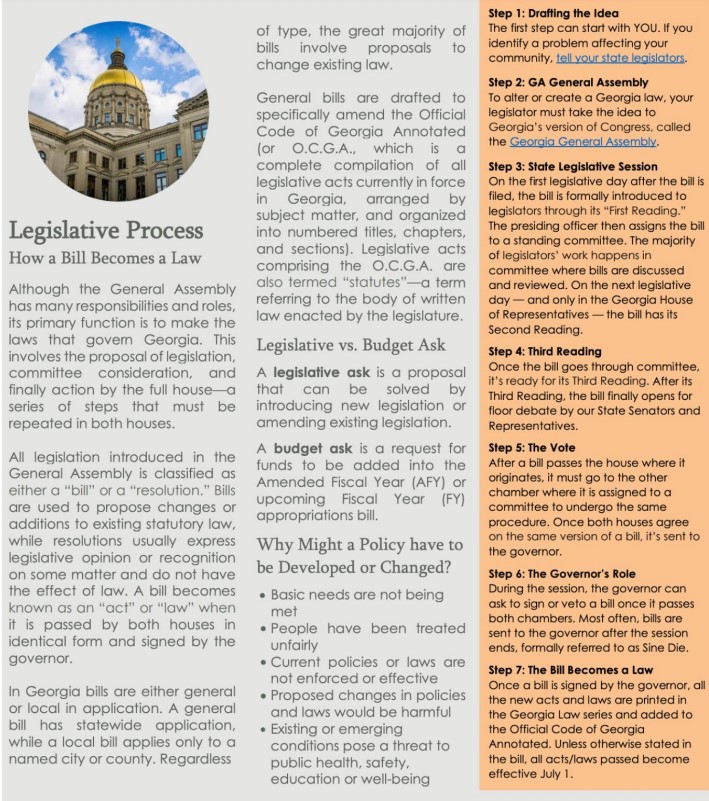View Advocacy Resources:
Effective Communication with a Policymaker
LP
The Legislative Process: How a Bill Becomes a Law

EC
Effective Communication with a Policymaker

Introduction
Policy makers can take different forms depending on the level of government (federal, state, or local) and the branch (legislative, executive, or judicial) in which they serve. State-level policy makers include:
- The Governor’s office;
- Agency staff;
- Members of the state legislature in both lower (House) and upper (Senate) chambers; and
- Judges presiding over various courts
Advocates, community members, and others working on issues at the state-level typically seek to spur legislative change. This guide supports these efforts by highlighting proven strategies for communicating with legislators with four distinct, but related, aims in mind: building relationships; planning events; identifying opportunities to engage in the policymaking process; and crafting a compelling argument to advocate for a position.
The four following sections of this guide are designed to be used both independently or together to help shape your advocacy strategy and connect with elected officials.

P1
Pt.1 of 4: Building Relationships with State Legislators
State legislators are often easier to develop relationships with than federal officials. On average, a member of your state’s lower chamber (House) represents about 60,000 residents, compared to 150,000 residents for your Congressional representative. Additionally, state representatives spend much of the year living and working in the communities they represent – strengthening the connections they have with community members and boosting their understanding of the community’s experiences.
The following section outlines strategies for building relationships with legislators representing your county, service area, or community, as well as those who might swerve as “champions” for your specific cause.
- Identify key legislators and their priorities
- Websites like commoncause.org make it easy to find legislators representing your county, service area, or community and obtain their contact information.
- This website also helps identify legislators’ priorities by listing the committees they serve on and the legislation they’ve sponsored. This information can help you figure out why which legislators are more inclined to support your cause.
- Ask a mutual contact for an introduction
- Policymakers meet thousands of people and it can be difficult to make a memorable first impression. An introduction from a mutual contact is a great way to ensure you stand out!
- Additionally, connecting yourself with someone a legislator already knows helps them understand how you tie into the community and shows them you have support of someone they trust.
- Attend town hall and coalition meetings
- Legislators often host town halls and other events to learn from the community and build support. These are great opportunities to meet them, ask questions, and raise issues and priorities on behalf of your community.
- Raising issues and voicing priorities in a public setting can help build awareness, attract partners, and hold policymakers accountable for promised improvements.
- Assign someone to serve as a “state ambassador” on behalf of your organization or coalition
- Duties could include tracking down town hall meetings and other community events; planning legislative office visits; registering to receive legislators’ communications to their constituents; and sending letters of introduction to elected officials.
- Build a media presence by writing op-eds in your local newspaper
- Media coverage can be persuasive when it comes to shaping policymakers’ views on various subjects. Increasing coverage of your priorities in the media will keep your issues top-of-mind.
- Plan an event to help elected officials get to know your organization
- Get to know legislative staff
- Legislative staffers serve a variety of functions, either by bring part of a legislator’s personal team, supporting the work of a legislative committee, or working on the state’s budget.
- Members of the public can set up meetings with legislators by reaching out to their office staff. These individuals are trusted members of a legislator’s inner circle and play a major role in deciding which issues receive a policymaker’s attention.
- Building relationships with committee staff, including both legislative and appropriations, is important because these individuals have a great deal of influence other whether policies get adopted.
- Write thank you notes after meeting with legislators and their staff
- Writing a thank you note after an interaction with a policymaker or their team communicates that you value their time and leaves a positive impression.
- Build a relationship and communicate priorities before the legislative session begins
- Short legislative sessions require legislators to introduce, deliberate, and discuss legislation at an accelerated pace. To be effective, it is important to get to know the policymaker and build support for your cause before the session begins.
- Prior to the start of the session, legislators are at home getting feedback from constituents, thinking about what they want to accomplish during the next legislative session, and how to accomplish it. It is perfectly acceptable to contact a legislator and ask them to have coffee (in-person or over zoom).
- Before the meeting, think about the key messages you want to convey and how you plan to convey them.
- Be concise and focused. if you are more selective with the information you deliver, you’ll generally be more effective than explaining everything about your organization to a legislator.
- Reach out to new legislators before they get to the capitol
- Term limits can make relationship-building difficult be creating consistent turnover in the states legislature. On the other hand, they also provide a chance to develop new, potentially stronger relationships every few years.
- Incoming policymakers won’t be surprised if you reach out to set up a meeting soon after they are elected – that’s part of the bargain of running for office! Reaching out early will increase the likelihood that you will be remembered once their term begins.
- Additionally, any legislator can pre-file a piece of legislation (even if they have not been sworn in yet), so shortly after they are elected is an ideal time to introduce yourself and build support for your issue.
P2
Pt. 2 of 4: Planning Events Involving Elected Officials
Why invite elected officials to events?
- Inviting legislators to in-person and virtual events hosted by your organization is a quality opportunity to educate them and begin building relationships: You set the agenda for what is discussed and capture their attention for a period of time (which is hard to do at the capitol.)
- Seeing your organization’s work firsthand offers a unique perspective on what you do, who you serve, and how you benefit the community. This is harder to capture accurately on a piece of paper.
- In-person and virtual events allow policy makers to hear from the people who are directly impacted by your organization’s work.
- Policymaker attendance may draw in other local leaders and can generate publicity.
- Policymakers are benefit from connecting with you:
- They get to interact with constituents and community leaders with whom they may not otherwise get to interact. Legislators want to be endorsed by the people who endorse you.
- Attending events allows them to learn about an issue from an organization that serves their community and helps them answer the many types of questions they get on a daily basis
Before you begin
- Look at the legislative schedule on your state’s House or Senate website to identify dates of interest – don’t schedule your event during big days at the capitol or legislative breaks. The same goes for scheduling advocacy days at the capitol.
- During election years, it can be challenging to get legislators’ attention in November. September through early October is the best time to reach out.
- After a state election and before pre-filing is a good time to reach out to newly elected officials and invite them to get to know you.
- Any legislator can pre-file a bill (even if they have not been sworn in yet), so soon after they are elected is an ideal time to begin building a relationship.
- Incoming policymakers won’t be surprised if you reach out and set up a meeting – that’s part of running for office.
- Answer the following questions:
- What is the objective for the event? What do you want the legislator to take away from this interaction?
- What are the key messages you want to convey? How will you convey them?
- What will the legislator do and see?
- Who will they meet?
- Be concise and focused. if you are more selective with the information you deliver, you’ll generally be more effective than explaining everything about your organization to a legislator.
- Be consistent with your mission, branding and advocacy goals
- This is VERY important in virtual events – possibly more so than for in-person events. Virtual meetings don’t have the same natural flow of conversation, so preparation is more important.
- Consider interesting activities to make your event memorable. For example:
- Meals on Wheels asks legislators to deliver meals in communities so they can see their impact firsthand.
- The Alzheimer’s Association does a simulation of what it is like to have Alzheimer’s.
- Firefighters have legislators try on equipment and try to run.
Creating events specifically for legislators
- Examples of events that legislators typically attend include in-person and virtual site visits, receptions, and panels to discuss the legislative priorities or issues in their community.
- You don’t need many legislators in attendance to make an event worthwhile.
- Tips for engaging site visits:
- Have someone greet the policymaker and make introductions.
- Publicly thank them for attending.
- Introduce the organization, share program highlights, identify strategic partnerships, showcase clients, and include multiple voices throughout.
- Scheduling with legislators can be very frustrating. They are often inundated with invitations they you will need to make yours stand out.
- Start scheduling with the office staff. Give the office a call and then send them a follow up email to invite them.
- When possible, use your network, Having a mutual contact extend an invitation as well will help raise the profile of your event.
- Timing is important – avoid scheduling near major elections and when legislators are at the capitol.
- Flexibility is key – be prepared to revise the date multiple times if you want a specific legislator to attend.
- Invitations can be sent vis mail or email. Explain the reason for the event clearly in the first paragraph.
- Follow up to confirm – don’t rely on just a verbal “yes” over the phone. Send a confirmation email including the policymaker’s role and what they can expect, timing, whether media will be present, contact information in case problems arise, and any other important logical details.
- Send a note, share photos on social media (tagging the legislator), and share posts by the legislator after the event to keep the connection going!
- If the meeting is virtual, taking screenshots of Zoom meetings is a fun way to get a group picture to use on social media.
- Remember: You don’t have to plan social events just for legislators. Inviting them to events that you’re already planning to host is enough!
- At the very least, invite the person who represents your district, but you can also invite those who represent your broader service area or the surrounding communities.
- Types of community events that legislators typically attend include:
- Community service/outreach programs
- Ribbon cuttings
- Staff/volunteer appreciation ceremonies
Engaging with legislators during a pandemic

- Inviting your legislator to a virtual meeting is a common way to connect. If you have never done this before, start with one legislator at a time.
- Have an agenda similar to that which you would use for an in-person meeting and start with introductions (both personally and organizationally).
- Virtual meetings need a concrete agenda to ensure that, in the midst of figuring out technology and facilitating instructions, you don’t forgot to deliver the important messages that explain why you’re having this meeting in the first place.
- Be creative! Take advantage of opportunities that you don’t normally have for in-person events.
- Maybe your executive director can’t travel normally because they are too busy, but they can join the beginning of a virtual meeting to start the introductions and thank the legislator for their time. Having the head of your organization thank them carries a lot of weight.
- Maybe you serve a broad service area and can’t travel to all parts of the state on a regular basis. Now you can meet with legislators that you normally can’t visit!
- Maybe certain clients of program graduates can’t normally attend in-person meetings in the capitol – now they can!
- Having a virtual meeting with someone you’ve never met before can be daunting, but legislators are used to this in their role. Nevertheless, it may be more conformable to have someone you both know on the call. You can ask a mutual contact to join for the first 15 minutes to break the ice and help the legislator understand how you tie to the community.
- Have an agenda similar to that which you would use for an in-person meeting and start with introductions (both personally and organizationally).
- Virtual celebrations and volunteer appreciation events allow legislators to support your cause, even if they are far away.
- For example, a legislator in in Missouri was able to give the opening remarks at a virtual Veteran’s Day celebration, which he normally would not have been able to attend.
- Habitat for Humanity has hosted virtual ribbon cuttings and invited legislators to attend.
- Virtual roundtables allow a panel of legislators to talk with community members about their priorities for the next legislative session and issues that are important to the community.
- Virtual demonstrations allow you to showcase new projects or raise awareness for your cause.
- Virtual receptions provide a forum for people who wasn’t to get to know a legislator that they haven’t met before.
- Provide instructions and follow with a questions and answer period.
- Keep the number of people relatively small (10 or less) to facilitate conversation.
- Inviting newly elected officials representing districts in your service area to a virtual event BEFORE they take office is always a good idea. This will increase the likelihood you will be remembered once their term begins.
- Though it is not required, it is perfectly acceptable to come to the meeting with a clear ask. Be honest with scheduling staff about your intentions so the legislator knows what to expect.
P3
Pt. 3 of 4: Know When to Strike: Identifying Points of Progress
Before the Legislative Session Begins
Between legislative sessions, policymakers are home getting feedback from constituents, thinking about what they want to accomplish during the next legislative session, and how to accomplish it. This is your opportunity to build relationships.
- Don’t be shy! Call a legislator and ask them to have a coffee over Zoom.
- Be honest with them, ask them about themselves, and learn about them – take the time to develop a relationship. Who knows, that person may be a member of congress one day!
Talking to members BEFORE the legislative session begins is also important because, in many states, lawmakers can file bills for introduction before the session begins (through a process called pre-filing). When they return to the capitol, they’re pretty much ready to go with the bills they plan to strongly support.
After Session Begins
Once a bill is filed, it has to go through committee. Bills get assigned to committee, but it is becoming more and more acceptable to ASK that a bill is assigned to a particular committee.
- This is an important intervention point for advocates. You can do this by sending a letter, an email, etc. to the presiding officer’s office.
What to do to increase likelihood of passage out of committee:
- If possible, ask for your bill to be assigned to a committee with a committee chair who is in favor of your bill to increase the likelihood hat it will advance. The committee chair is important because they decide what bills will be heard, voted on, and turned in.
- The committee chair has many bills to consider, only a few slots to advance a bill, and lots of people asking him or her to prioritize their bill. If you have a bill that is non-controversial, you can ask for the bill to be placed on the consent calendar. The committee chair doesn’t have any limitations on consent bills, so this will increase the likelihood that your proposal will advance. One caveat is that the bill can’t have any “no” votes.
- The second thing you can do to increase the likelihood of advancement is think about your bill as an amendment as part of a larger package. Sometimes issues that don’t even relate to one another end up in a single piece of legislation. Lumping them together into a larger package allows for more proposals to pass through the limited number of slots.
- Talk to EVERY committee member.
- Identify the weaknesses to your proposal and address them. Be open to the idea that some people might object or have other ways of doing what you want to do.
- Identify the people who will be opposed and think about how to bridge the gap. (Note: this is not always possible.)
- Politely but firmly request movement.
- Things not screaming for attention will not get attention.
- Ask your bill’s sponsor to seek votes and hearings consistently when there is opportunity.
- Regularly communicate with your sponsor, empower them with information, and remind them how important they are to motivate them to act.
Before a bill can go to the floor it has to have a “hearing.” This is a formal point for community engagement in the process.
- The hearing is one place where advocates are invited in to provide and hear testimony.
- If similar bills have been introduced in the past, look up who testified for those bills to identify potential allies.
If the bill goes to the floor, you will need to get buy-in from the majority floor leader.
- Let him or her know you did a “vote count” on the bill and tell them how many members like and will vote for the bill. You can also point out how many members don’t feel strongly about the bill. hat shows the floor leader that there won’t be a lot of issues with it.
- Let the floor leader know you resolved any issues before the debate.
- Who had a problem with the bill? What did you do to fix it?
- Communicate with your sponsor and key players – tell them who has had problems with the bill, anything else they need to know, and refresh their memory about the information in the bill so they can stand up and talk about it on the floor. You should also talk to other supportive legislators and make sure they are prepared, as well.
If the bill passes the floor, you go through the same process over again in the other chamber.
After session ends
Once a bill passes both chambers and is signed by the Governor, it becomes a law. A regulatory agency assigned to implement the law then proposes regulations and invites the public to comment.
Comment period provides an opportunity for the public to weigh in on the specifics of how a law is implemented before finalized. This is a prime opportunity to highlight important issues for consideration.
P4
Pt. 4 of 4: Making a compelling argument
Identify the right actor to address the problem
There are three types of policies that might contribute to the issue you are trying to address. It is important to know the source of your policy of focus to identify the people who are in the best position to act.
Laws and regulations
A lot of times, it is not a law that needs to be changed, but the interpretation of the law. In these cases, you can appeal directly to the agency that created the rule to change it.
If your barrier is a regulation, there is nothing wrong with going to the agency to inquire why a statute is being implemented in a certain way. Agencies can be creatures of habit, but that doesn’t mean things have to be done in the way they have always been done. If you take the approach of ‘help me understand this/let’s figure this out together,’ sometimes agency staff will realize that there is a better path forward.
Administrative policy
Types of administrative policies include departmental policies, rules and regulations, and executive orders.
Case law or court action
Courts are a branch of government that spend their time interpreting the laws that we’ve discussed above. Some policies result from instances where there was a lawsuit and a judgement was determined. Increasingly, people are going back to the legislative because a court decision was the source of a policy that they want to change.
If the solution to your problem requires legislation
Before the meeting
Understand what you’re trying to accomplish. Do you want to:
- Introduce a new law?
- Change an existing law?
- Support for challenge someone else’s decision to introduce or change a law?
Be familiar with the key players, the legislative process, and use the language
- Language matters – you have to speak the lingo in order to make policymakers respect you.
Make the connection between your issue and key legislators’ professional or personal interests.
- It’s hard to make the system work for you if you don’t have relationships with, or an understanding of, the individuals involved.
- Most states have legislator webpages that show all the legislation an elected official filed during their time in office, helping you to identify their background and their priorities.
- A legislator’s webpage helps you figure out what they care about, what their background is, and how you can connect your community’s priorities to their interests.
Understand key influences
- Personal – The individuals who are closest to the legislator.
- Professional/Leadership – The affiliations/positions that provide a livelihood and/or opportunity for public service for the legislator.
- Community – The factors within the community that impact the legislator’s perspective (local media, the old men that sit in the coffee shop in McDonalds, etc.).
- Trade organizations and industry – The groups working to influence legislative priorities that contribute to policymakers’ campaigns.
Evaluate your connections
- Even if you don’t know a legislator, you may be able to reach out to them through your existing network. Ask yourself: Who do you know that is connected to the person you want to reach?
- Leveraging mutual connections expands your reach exponentially – Who are the people that can amplify your message to legislators? How can you engage with them?
- Identify opportunities to be around a legislator (debates, town halls, parades, etc.).
Understand the policy environment
- Majority party leadership – Caucuses set the tone and shape large blocks of major policy changes.
- Minority party leadership – Not as structurally powerful, so they must rely on interpersonal skills/traits and qualities to make them powerful. Their influence depends on:
- The margin – The smaller the margin between parties, the greater the influence.
- Ability and savviness – Understanding and seizing opportunities.
- Other leverage – For example, control of the other chamber or the executive office.
- Political timing – Take advantage of times when issues are gaining elected officials’ attention.
- Media – Advocates’ ability to seize opportunities to talk about issues they care about in the media will go a long way toward making the issues important to legislators.
- The Administration (executive control) – When the administration and legislature are controlled by different parties they can counterbalance each other.
- Some states, like Missouri, have a very strong executive branch, while others, like Florida, do not.
- Individual lawmakers – A policymakers’ influence depends on several factors:
- If he or she has an official position in the chamber, that is great!
- His or her demeanor – whether they are well-liked by their peers.
- If you can get these people to support your issue, others will likely follow.
- Political savviness – his or her ability to identify and seize opportunities.
- Money – There is no such thing as being outside the election cycle. Campaigns are expensive so, if you have money to donate to their campaign, you have influence on legislators looking to run again.
- Interest groups – Industry and ideological organizations that attempt to propose agenda and influence policies.
- Don’t think about your issue as “I’m right and others are wrong.” Your perspective should be “I have an issue that matters, and I need to raise the level of urgency around it so I can make a needed change.”
Know your value
- Elected officials are never not running for office (mentally). Legislators need votes, so they want to create good will. If a legislator is associated with you as a reputable community group, they get to share your good will in the communities you serve.
- Nonprofits have community relationships and community expertise. You live in the communities you represent (unlike professional lobbyists who live in the capital.) Use this to your advantage by developing relationships with key people who live in your district like local reporters, county officials, etc.
- State legislators want county officials to support them because it brings big votes.
- County officials might end up being future state legislators themselves!
- Sometimes legislators need someone to help them understand what the right thing to do is. Your perspective is needed in the capitol to:
- Bring attention to the needs of the underserved.
- Represent the interests of local communities.
Identify the best messenger
- Messenger equals message in many instances, so try to broaden your messengers.
- If you’re worried about being seen as too liberal, it helps to find a partner that has respect in the conservative community, but still supports your efforts. Their endorsement can add legitimacy and help get your message across.
- Groups that represent business or agriculture usually have conservative chops. You may disagree with them on other issues, but can come together strategically and then part ways.
- If you want to pass a specific piece of legislation, you can look up similar legislation that was introduced previously to see which groups testified in favor of it – they are potential partners.
Develop solutions
- Identify the action that is required.
- Do you need a law passed? Do you need more money added to a budget?
- How does it relate to other factors?
- A multi-pronged approach targeting different type of policies (like laws, regulations, administrative policies, or court decisions) may be needed to fix a specific problem.
- Seek to fix the problem – not push a specific solution.
- Allow space for different solutions, You have to be prepared to abandon YOUR solution to the problem.
- This can be hard because you probably think your solution is best, but there may be other potential solutions that are more agreeable to the people/groups you need support from.
- Remember that all policy gains in one area require a policy loss in another area. It is important to think about what the unintended consequences are.
- Allow space for different solutions, You have to be prepared to abandon YOUR solution to the problem.
During the meeting
The goal is not just to talk to legislators but to make them LISTEN!
- This question should be “does this person need to hear this” NOT “do I need to say this?”
Create common bonds – empathize common community, common interest, common people.
- This is easier to do in smaller or rural communities than large, urban communities.
- Read through legislators’ online biographies to learn about what they believe in, the committees they serve on (which usually match their interests), and their community/professional ties.
- No matter what legislators believe in, almost all have a desire to serve/improve their communities. Bonding with them about that is a good idea.
Define yourself
- Identify yourself as an expert on your issue. You are a resource to policymakers who don’t know what you know! Use and rely on your expertise to move your agenda forward.
- You also want them to see you as a community partner. You are taking care of the community and people that they care about.
Make your issue stand out from the crowd by connecting it with a larger agenda
- If a legislator has filed 15 bills related to clean water, tie your issue to clean water! Find the common connection if it exists.
Emphasize public appeal
- Typically, the issues that advocates work on have some sort of public appeal. Legislators get to associate themselves with YOUR positive public image by working with you. Remind them of that.
Marry personal stories to data
- Storytelling is a powerful advocacy tool that puts a “human face” on facts and figures. Storytelling can help legislators understand and emphasize with your issue and motivate them to act.
- Conversely, backing stories with data can demonstrate how an individual’s experience is representative of a larger problem.
Define your solution
- Make your ask specific in order to be actionable.
- Make asks/solutions achievable.
- Make it measurable.
Make it participatory – help legislators understand that they have a role in what you want to achieve.
- Almost every legislator has a meeting, they expect that someone will ask them for something. The more comfortable you become with making requests from them, the more successful you will be.
Communicate your message in 2 minutes or less, make 2 points (max), and fit everything they need to know on 1 page that you can leave behind.
Finish strong!

- You had a great meeting and are ready to say goodbye. The final question from the legislator is “What can I do to help?”
- The ASK can take many forms. Legislators are well connected individuals in their communities. They can help you with many other things besides passing legislation.
- Ask them to support a specific problem or initiative
- Everything in an appropriations bill has a line item – know what the bill and section number is.
- Give the amounts and what it means to the community and others.
- Tell them who is initiating the funding cut and what needs to happen to put that line item back in.
- Identify the actors who make decisions about appropriations and acknowledge that other legislators may not know that much. Ask them to speak to the right person and make your ask on your behalf.
- Write this information down for the legislator so that it’s easy to remember when they go to the floor.
- Asking them to vote for your bill
- Tell them the bill number, bill sponsor, where the bill is in process (this is a great opportunity to use the vocabulary), what the bill does, and why the bill is important (why is this bill worth spending time on over other bills that they’ve been asked to support?). This information will let the legislator know that you’re a good partner.
- It’s also a good idea to have a couple of different asks ready depending on how much the legislator wants to commit.
- Ask them to come to your event
- Inviting legislators to events that you are hosting helps develop a stronger relationship.
- Allowing the legislator to SEE what you do makes your program/organization relatable and creates anecdotal evidence/a narrative to go with the data. This is incredibly persuasive to legislators, especially if press is covering the event and you give the legislator a public nod.
- Ask them to help you convene a group to…
- Legislators have phenomenal contacts, including civic leaders, business leaders, education leaders, etc. A request from a legislator is a great way to get a leaders attention.
- This is specifically good if you are building a program because the legislator get to take a little credit for that.
- Asking them to introduce you to…
- Legislators can provide easier entry into other groups, like the ones identified above.
- They can also recommend a person for you to talk to if you don’t know who the right person to tackle your problem is.
- Ask them to support a specific problem or initiative
- No matter what your ask is, make it easy as possible for them to do what you want. Give them everything they need to take action.
After the meeting
Think about the meeting as a starting point, then nurture the relationship to create something more significant. Building a relationship over time will pay dividends in unexpected ways.
Always have one thing lead to another. Leave the meeting with something else to talk about.
- Promise to follow up the meeting with additional information in a reasonable amount of time (one week or less).
- This can be an email, note, another visit with staff, etc.
- Send a thank you note – common decency goes a long way at the capitol.
- This is pretty unusual, so you will get noticed.
- Putting in the extra effort tells the legislator you’re in the relationship for the long haul.
- It’s totally okay to circle back with a legislator and tell them you forgot something.
- Send he legislator articles about things they are interested in or work on, even if it doesn’t have anything to do with the issue you talked to them about. They’ll appreciate the gesture.
If you ask the legislator to vote on something and they do, follow up and say think you.
- If they vote no, ask them what changed since your conversation and if they can help you understand what their rationale was. This makes them recognize that they will be held accountable for promises they make and helps you improve your strategy.
- The vast majority of people don’t hold them accountable and, if you do it, you will stand out.

